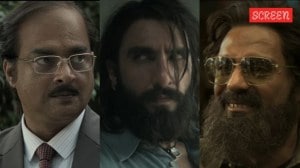Remember Bombay
The city needs to reach into its past for a wiser, more accommodative self

The shenanigans of Raj Thackeray and his Maharashtra Navnirman Sena have shocked Indians everywhere. It is likely that such scenes — of young men being beaten up and taxis being bashed in — might have seemed less horrifying had they occurred elsewhere. But the fact that such mayhem and cold-blooded violence can occur, and continue unchecked in the country’s most developed and progressive city, has terrifying implications for the rest of the country.
At one level the issue concerns the pull between regionalism and cosmopolitanism and is a worrying phenomenon for a country galloping towards greater urbanisation and modernisation. But at another level the phenomenon also reflects the changing environment in the city of Mumbai. To understand this more clearly one would need to go back in time.
To August 1984, for instance, when the Indira Gandhi government dismissed NTR as chief minister of Andhra Pradesh. The day after or thereabouts there was a public meeting called at the University of Mumbai, then Bombay, to protest against the unconstitutional act. Before the scheduled time, the vast hall was full. Mostly with ordinary people, many with briefcases getting home from work. I don’t recall who spoke that day. It could have been eminent jurists, local politicians, civil libertarians or independent citizens. It could have been Nani Palkhivala, Minoo Masani, Durga Bhagwat, Madhu Mehta and Madhu or Pramila Dandavate. It did not matter. The significant thing was that we in Mumbai felt a duty to speak up at a time of national crisis and there was a place and people who could do it for us.
It was the post-Emergency era, so anti-authoritarian feelings ran high. The mood could be perceived in a host of areas. In the legal arena, where public interest litigation was handling issues such as the treatment of undertrials or at the high court where a former chief minister was being tried for corruption. Feminists in Mumbai like their peers in other cities were agitating against dowry deaths and pulling down obscene hoardings. Urban environmentalists were successfully demanding action against those flouting developmental rules in the city.
The city was being remade by two significant events: the plight of the textile industry and the Datta Samant-led textile strike; and slum demolitions which brought several young lawyers to the aid of the dispossessed.
Film directors were making startling politically relevant films and theatre directors, including a fiery Vijay Tendulkar, were producing thought-provoking, experimental work. The Asiatic was not only Mumbai’s biggest public library but also a meeting point for many including leftist intellectuals while places such as Coffee Centre, Wayside Inn and Samovar were informal addas for writers, artists and others. And all of the ferment was reported back to Mumbaikars by a lively city-based media that consisted of a variety of publications both in English and the vernacular: daily newspapers, financial papers, weekly tabloids, eveningers, Sunday papers and features magazines.
I recall this time not to point at a golden age when everything was wonderful but to recall a time when the city’s mainstream bristled with multiple issues, when debate and litigation were perceived as valid ways to settle differences, when imagination and compassion were evident among people who could afford to look away and when Mumbai was a city which mattered in the national context, not just as a source of entertainment and money but also as a centre of thought and deliberation.
Twenty-five years is not a long time in the life of a city but so much has changed. Much has been written about the city’s wealth, its burgeoning size and its infrastructural plans and constraints and its world of stars and crime. There is more interest worldwide in the city than ever before. But little note has been made of what it has lost over time.
The media is a clear case in point. Many local publications have closed down or declined. Despite the media boom, Mumbai now is covered increasingly from the outside rather than the inside. The fact has significant repercussions for the manner in which it is covered which is with less complexity and a tendency to exaggerate the sensational aspects in preference to others. The image of Mumbai as the centre of the entertainment industry also has serious consequences for its self-image. The local elite for instance, which may have once consisted of creative minds or socially responsible individuals, is increasingly redefined to exclude all but the rich and glamorous.
The all-round emphasis on consumerism has led to a reduced awareness of serious issues and politics, particularly state politics. Demonstrators that once flooded the central Kala Ghoda area protesting about a host of issues have been moved out to less conspicuous locations. Local demonstrations on political issues, when they do take place, do not get the attention of the mainstream as they once used to. Issues that are hotly debated tend to be about infrastructure or civic issues, issues that affect the immediate environment.
State leaders have always connected more with problems in the rest of Maharashtra but even within Mumbai there are fewer and fewer public personalities that could command the respect and attention of a large populace. Political correctness or other considerations stop its celebrities such as sports stars from taking public stances. And among film actors: Dilip Kumar is ailing; Sunil Dutt is no more; and the current crop of stars are denizens of the world and not just of Mumbai. Even the underworld that held pockets of the city is now scattered across the globe.
Equally significant is the image of Mumbai outside Mumbai. One would be hard put to find experts on areas such as national politics, foreign policy or nuclear policy and partly this reflects a diminishing respect for knowledge in the city: the consensus at a recent talk on the subject for instance was for niche need-based libraries and not vaults of general wisdom.
Nature abhors a vacuum. Raj Thackeray’s agitation may stem both from a thirst for power and a real tension between the regional and the cosmopolitan. But in the absence of varied issues — many of them far more problematic — and in the absence of discursive forums any flamboyant expression of discontent or intolerance is likely to acquire an exaggerated presence. Mumbai needs to reach into its past for a wiser, more accommodative self.
Mumbai-based Shah is the author of ‘Hype, Hypocrisy and Television in Urban India’
expressexpressindia.com
- 01
- 02
- 03
- 04
- 05































